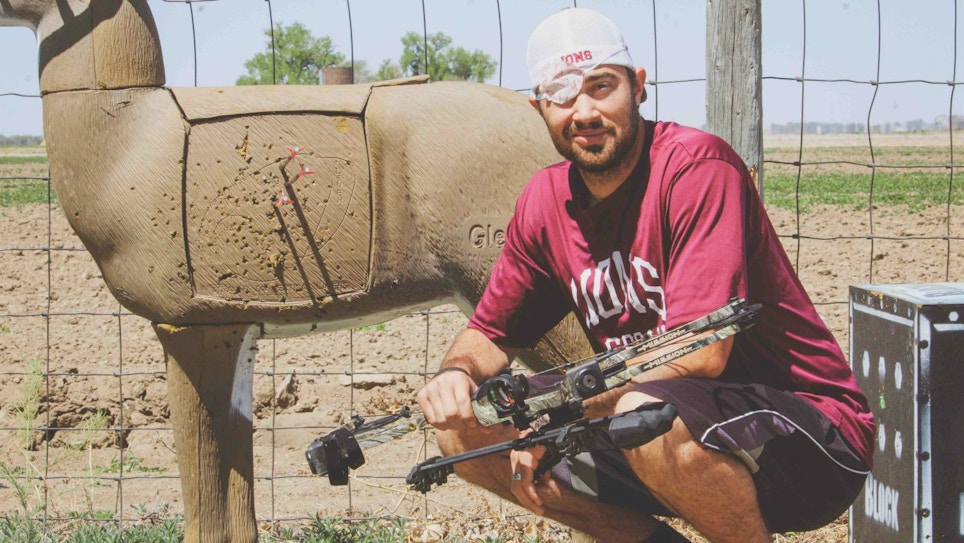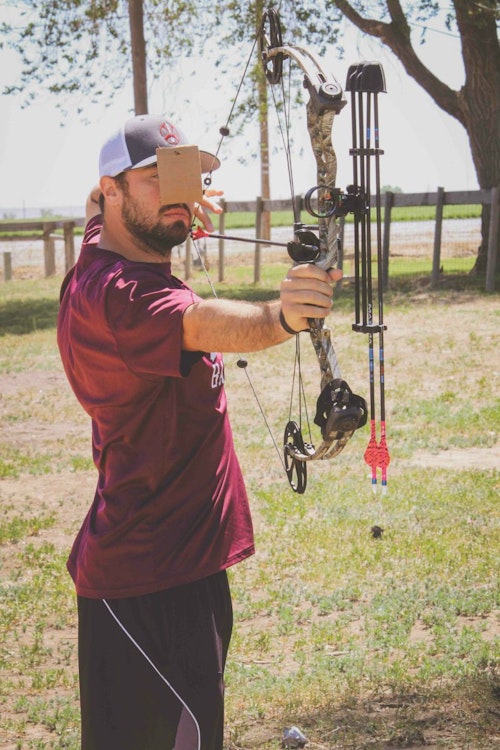During my archery tenure, I’ve coached throngs of shooters. I love it. Helping others is what I do. But this one had me stumped. She had great form her grip was perfect, and the draw was smooth. Two anchor points were found, and her finger wasn’t feathering the trigger. Her pins, however, as she put it, “Were out of position.”
The young lady was right-handed. I was sure of that. Then, it hit me. It had to be an eye-dominance issue. I placed a gold pin on a black surface and moved her back 5-feet from the pin. I asked her to keep both eyes open and use the index finger on her right hand to point at the pin. Next, I asked her to close her left eye. The object moved. When she closed her right eye, her finger remained on the pin. She was right-handed but left-eye dominant. As she moved farther back from the pin, the amount her finger moved off the object increased significantly.
I did another test just to confirm. The Miles test requires the archer to extend both arms and bring their hands together to create a tiny opening. The shape is usually a triangle but can be a square. Both eyes will focus on a distant object through the opening. The archer then draws their hands back to their face. Whichever eye the opening gravitates to is the dominant eye. Once again, the test showed her the left eye to be the dominant one.
What Is Eye Dominance?
According to optometrist Jordan Ballantyne, owner of Ballantyne Vision Care LLC in La Junta, Colorado, eye dominance is simply how the eyes line up with an object. When aiming at an object, one eye will naturally take over.
“If you’re right-handed and left-eye dominant,” aiming is going to be a bit of a problem for you,” Jordan said. “You’re going to be pulling the bow back with your right hand and trying to line up your sights with your right eye. The problem is, your brain is not used to aiming with the non-dominant eye. If you’re right-eye dominant and right-handed, or left-eye dominant and left-handed, it isn’t an issue.”
What Can You Do?
As a coach, your job is to help your clients shoot better. Coach long enough, and you’ll have multiple shooters struggle with accuracy issues that stem from eye dominance. Aiming is a fine-motor skill. When archers can’t aim, they panic. When they panic, the joy of archery gets sucked down the toilet.
Archers that are right-eye dominant and right-handed or vice versa can shoot with both eyes open. This is a huge advantage. In addition to increased light-gathering, the brain is getting fed with double the visual data. The dominant eye naturally takes over and aiming becomes easy and natural. Pins align with the target, and the archer can breathe and execute. That’s not the case for the eye-dominant challenged.
In the case of this young lady, as previously mentioned, she was right-handed and left-eye dominant. This caused her to have to close her dominant eye. But, because the eyes are controlled by both hemispheres of the brain and the muscles around the dominant eye were the strong ones, the muscles would twitch terribly, and the eye would start to open mid-shot, which really screwed things up.
If you get a shooter with eye-dominance issues, you have some options. First, they can learn to shoot with their non-dominant hand. This will take time and a lot of relearning, but it can be done. If eye-dominance issues are severe, this may be the route you need to direct the shooter towards.
A shooter may not like it, but a pirate patch is another option. An eye patch that covers the entire eye allows the shooter to leave the dominant eye open but forces the non-dominant eye to take over. Many shooters find this comfortable. A piece of cardboard clipped onto the hat is another option. No, it won’t block out all the light, but it will block out enough light to cause the non-dominant eye to take over. Shooting with an eye-patch or cardboard over the eye can remedy the problem. Your non-dominant eye muscles will get stronger, and muscle memory will take over. I know this firsthand.
When I first started shooting a bow, I discovered I was right-handed but left-eye dominant. I went the eye-patch route. I shot for months with a patch. Then, I graduated to just closing my left eye while shooting. Next, I started letting my left eye squint a little. Today, I shoot with both eyes open and have zero issues. Did I train my right eye to be my dominant eye? Doubtful, but I developed good muscle memory. Of course, it will depend on the person, but eye-dominance issues should never rob a person of the joys of archery.
Sidebar: Patches and Cardboard
Have some fun beating an eye-dominance dilemma. Visit your local craft store and purchase some elastic bands. Next, pick a fabric. When I was wearing a patch, I had many different makes. I would wear one color fabric for practice, another for 3-D shooting and another for hunting. Cut a circular piece of cloth and sow on an elastic band. Viola! You’re done. The patch, because it’s soft fabric, will be comfortable.
Wanting to go the cardboard route? Take a piece of cardboard, cut out a square, make two small slits and use a heavy-duty paperclip to attach the cardboard to your cap. It’s easy, cheap and simple.
Sidebar: Eye Exercises
As archers, we depend heavily on our vision. While there aren’t a ton of exercises you can do to ensure a specific eye becomes your dominant one, there are some great exercises you can perform to keep your eyes healthy and your vision sharp.
“The only way one could truly change eye dominance is to remove an eye,” Jordan said with a laugh. “I actually read about a patient that had less than 20/20 vision in one eye and had to have his other eye surgically removed due to some medical issues. The brain starts putting all of its focus to the healthy eye. Later on, it was discovered that the brain actually trained the other eye and his vision in that eye got as good as 20/20.”
One excellent eye exercise and one that is simple is to hold a pencil in front of your face and move the pencil left, right, up and down. Really stretch those eyes. Don’t move the head at all. Move the pencil in each direction until your eye can no longer track it. This is great for stretching and building the eye muscles.
Another great exercise is to visit your optometrist and get a pair of letter charts. One will have larger letters, and you will hang this one on a wall about 20-feet away. The other chart will have smaller letters. This chart will be held in hand. This is a one-eye-at-a-time exercise. You will read a row on the far chart and then immediately switch focus and read a line on the chart you’re holding in your hand. According to Jordan, this will really help with focusing.

“Be sure, with the close chart, to get it as close as you can without making the letters blurry," he said. "Go back-and-forth between the two charts several times. This will strengthen the connection between your brain and your focusing muscles. You’ll learn to switch your focus in a heartbeat. You don’t want those muscles to ever get sluggish.”








